Unit 6 Collective Impact, Mission, Vision, Values, Goals, Servant Leadership, Productivity, and TSL

Overview
This unit addresses resiliency and collective impact. This review will help with understanding the importance of collective impact practice and process with employee groups from different areas of responsibility/sectors committed to solving complex social and sector specific environmental problems. Exploring collective impact is more than collaboration. It is a clearly defined and structured problem-solving process designed to benefit the whole more than the individual.
Reviewing adaptive cycles within organizations helps make sense of organizational practices by considering hierarchical systems attached to defined interrelated processes. Organizational mission is the high level statement of what we do. When looking at values, both mission and goals are important elements of understanding the leadership journey personally, professionally and corporately. Taking stock of where we are in the process and working toward effective outcomes related to values keeps us focused on what is important to ongoing organizational success.
Topics
This unit covers the following topics:
- Collective Impact
- Adaptive Cycles
- Mission and Transformational Servant Leadership
- Values, Vision and Goals
- Servant Leadership and Productivity
Learning Outcomes
When you have completed this unit, you should be able to:
- Identify the benefits of TSL resilience loops in their organizational operation.
- Recognize the importance of implementing effective employee engagement principles for best practices results.
- Describe best practices for developing employee/staff performance processes in their organization.
Activity Checklist
Here is a checklist of learning activities you will benefit from in completing this unit. You may find it useful for planning your work.
Learning Activity
- Learning Lab Preparation: The Learning Lab for this unit will consist of a group discussion. Each student will be required to prepare for the discussion prior to arriving to class. Guiding questions, and an overview of the discussion topics, can be found by selecting the “Learning Lab” tab.
Assessment
-
Unit 6 Assessment: Discussion Question/Reflection
Post: The first assessment for Unit 6 will be a post on the
discussion forum. Be sure to carefully read through the instructions as
you are responsible for completing three separate posts (and responding
to your peers). Click on the “Assessment” tab for additional
information.
- Unit 6 Assessment: Team Assignment #1: An outline of this assignment can be found by clicking on the “Assessment” tab. For this assignment, you will be working with a team to create a presentation. While your Facilitator will help organize groups, it is important to make sure you organize scheduling/preparation/planning with the other members of your group. Be sure to read through each step of the assignment carefully. Once you have completed your assignment, you will submit it for grading.
Resources
Important: You need familiarity with core course texts. The course texts listed below are for your daily preparation. Pre-reading course texts, prior to the course start, then re-reading content for each day of assigned reading will deepen understanding of content and allow you to engage materials more completely.
All other text resources for daily reading are available online where you can retrieve them on the Unit page where the reading is required for completion to fulfill learning outcomes for the unit.
Here are the required resources you will need to complete this unit:
- Delahaye Paine, K. (2011). Measure What Matters: Online Tools for Understanding Customers, Social Media Engagement, and Key Relationships. - Read the Epilogue and Appendix 1
- Eurich, T. (2013). Bankable leadership: Happy people, bottom- line results, and the power to deliver both. - Read Part 4 – Be Happy and Drive Productivity
- Friedman, Mark (2005). Trying Hard Is Not Good Enough. How to Produce Measurable Improvements for Customers and Communities - Read Chapter 4
- Ulrich, D., Smallwood, N., (2013). Leadership Sustainability: Seven Disciplines to Achieve the Changes Great Leaders Know They Must Make - Read Chapter 8
6.1 Collective Impact
We begin Unit 6 with an understanding that resiliency and collective impact go hand in hand. Collective impact occurs when a group of employees, from different departments or within the same sector commit to solving complex social and sector specific environmental problems within their areas of responsibility, and is more than collaboration. It is structured problem solving.
For collective impact to work, a group needs to identify and commit to working toward a shared vision, while focusing on the change agreed to, with a common understanding of the problem(s) at hand. Groups work together to solve problems through agreed upon actions, requiring constant and effective communication in several areas.
Generally, the simplest way to create this type of communication is through interoffice channels. Emails and electronic connection points, like Google Hangout or Google Docs, utilize several formats to communicate effectively to make progress. The more complex the communication gets, the greater the requirement for formal communication. Larger organizations may need meetings with recorded and distributed minutes, with key representatives from each department involved in the process and with each department or organization taking responsibility for important issues. When sector-focused companies negotiate for collective impact, communication needs to be greater in scale and complexity.
Representatives can meet to discuss the best ways forward and ensure consistent and open communication with one another at the local, departmental or inter-interagency level. Effective communication structures ensure everyone works toward the same goals and create the best momentum toward achieving those goals by collecting and measuring data consistently across all sectors. Effective communication depends on giving opportunity for everyone to talk, create and manage collective impact together.
A working group requires consistency management, so it is best to make one person responsible to remind the group of important deadlines and dates. This might involve a department or project chair, or an organizational representative. The group might choose someone with a managerial role to ensure followed up and work within collaborative departmental or agency protocols. This might also require enlisting staff with specific skills for coordinating local, departmental or interagency representatives to develop mutually reinforcing action plans. This isn’t a “maybe this will work” approach, it’s an organized and responsive focus on working toward desired and focused results.
Looking at differing performance measurements, evaluating activities and understanding the progress of collective initiatives are important for developing a collective impact strategy. As the plan matures, collective impact must create value for everyone engaged to avoid imbalance. Collecting and analyzing data to effectively communicate findings is a challenge. There are many ways to manage and design collective impact for enabling organizations to assess progress collectively and effectively. Seeing the framework and design through the lens of several different approaches frees the organization(s) from the limitations of seeing the plan through a singular lens. It is not a one size fits all. Each plan is uniquely developed with success based on the level of communication and planning departments or agencies need to engage.
Utilizing shared performance measurement systems while developing necessary frameworks is enhanced by proper evaluative approaches and communication.
When looking at collective impact and its initiatives, there are a variety of internal and external factors influencing, design and progress. You may need to determine best practices for operating within your values leadership to identify high level questions for determine outcomes, identifying indicators and next steps. When selecting evaluation questions for your collective impact, create open ended questions to allow evaluators to explore a wide range of factors and influence drivers within the organization’s collective impact.
Below you will find some suggestions for how to approach building an effective framework in your organization.
Building an Effective Framework - Click to expand.
Effective Questioning
Effective questioning, looks at key elements for assessing progress through the established collaborative network. The more you communicate and ask questions, the more you ensure goals are aligned and can establish a common agenda. This enables you to look at the infrastructure and agree on how things are done. Establishing mutual respect and cooperation, by looking at decisions to provide balance to the sector, can create stimulating approaches to solutions you’ve never tried before. Be willing to try and fail rather than to try only when success is virtually guaranteed. If you only consider 100% success rates, you will find yourself frustrated and people will begin looking at process and suggestions as invalid.
Groups make better changes and align goals more effectively when the process requires continuous communication and a willingness to work towards building a learning culture throughout. Working together, however, regardless of how amicably, you’re not going to agree on or settle for satisfaction every time. When internal, interdepartmental or interagency organizations review what they’re doing with a good infrastructure, everyone has the opportunity to commit to accomplishing what they agree on. It may seem simple, but within communication frameworks, sharing measurements and reinforcing activities should encourage equal contribution.
Decision Evaluation and Data Collection
Decision evaluation is a constant process for creating collective impact. The Missouri Foundation for Health (MFH) case study records MFH accomplished goals departmentally for collective impact in their sector. Measuring impact is important for fulfilling agreed upon responsibilities. You can’t sit on things that hold you back, but neither can you push things through that stall progress. Commitment to collective impact needs to be mutually conducive to all parties. Good data requires thoughtful decisions about what you are measuring and the results you are looking for to help make progress and create collective interest in the change required. Central to ensuring collective impact moves forward is ensuring you have records related to documents, observations, surveys and interviews for understanding and disseminating the information received. From hard data to social media and social network analysis, ask questions like:
- What systems mapping will you include?
- Is what you have decided easily understood?
- Is your plan or proposal easily understood?
You need to make sense of data. Make sure everything you share – every measurement accomplished, through numbers, pictures and words – make sense of results. This involves reflecting on and discussing the meaning of analyzed data. People looking at the data or the results should not need to ask what you are talking about. You need clarity. Otherwise, collective impact dissipates and dies.
Relational differences and finding patterns and themes in data, begins building quantitative and qualitative information to help move things to the next level in the collective impact process. Conceptually, there must be “aha” moments, even if very small in the scheme of things. When the information is used for legitimate purposes, communicated to everyone engaged in and affected by the process change, the process can become large and complex.
Team Meetings
Teams need team meetings, and departments need departmental meetings, and interdepartmental or interagency cooperation needs interdepartmental or interagency meetings so everyone is aware and understands where they’re going and why they’re going there. This allows everyone to grow through the collective impact process.
Budgeting finance, energy, effort and process are at the core of collective impact. Learning to communicate and collaborate across sectors, set shared goals to assess progress and use data to make decisions for generating momentum and shifting systems, changes behavior and solves complex problems at the local, interdepartmental and interagency level. By evaluating, you create focus on important aspects of collective impact and begin helping organizations move toward the potential progress they plan.
6.2 Adaptive Cycles
Before Your Begin…
The concepts outlined below can be challenging to understand. Before you begin, take a moment to read through the following articles:
These articles will help provide a foundational understanding to provide some context for the content in this section.
Understanding and implementing collective impact requires the adoption of adaptive cycles. Adaptive cycles occur organizationally by processes moving from the exploitation of opportunities, conservation of purpose, release to growth and future reorganization. An adaptive cycle exhibits two major transition points. The metaphor of the adaptive cycle makes sense of evolving practices in the organization by making sense of hierarchical systems and interrelated processes.
Adaptive cycles build ecological and sociological systems from nested sets. Large slower cycles constrain smaller, faster ones to maintain system integrity. Faster levels invent, experiment and test slower levels to stabilize and conserve accumulated memory.
The Panarchy Model
The Panarchy model suggests that systems follows a four-phase adaptive cycle of (1) “exploitation” (r); (2) “conservation” (K); (3) “release” (Ω); and (4) “reorganization” (α). Quoting the Resilience Alliance: “The adaptive cycle exhibits two major phases (or transitions). The first, often referred to as the foreloop, from r to K, is the slow, incremental phase of growth and accumulation. The second, referred to as the backloop, from Omega to Alpha, is the rapid phase of reorganization leading to renewal.” Take a look:
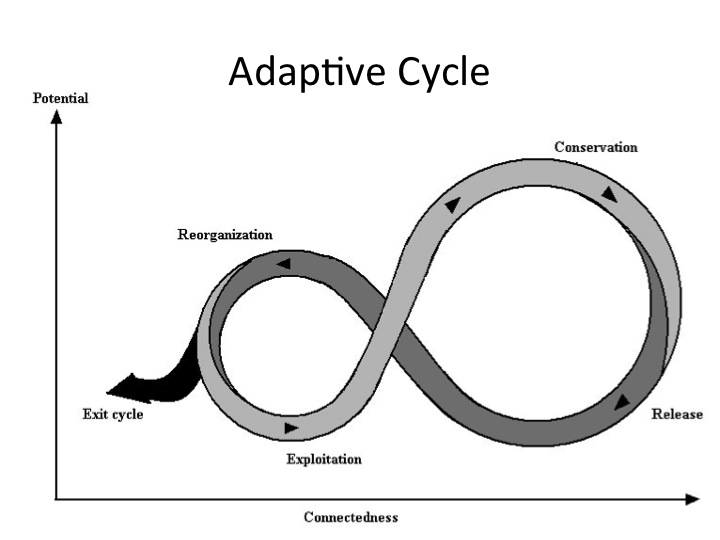
The metaphor of the adaptive cycle helps to make sense of the evolution of practice in organizations as depicted in the figure below. Similarly it can help to make sense of the evolution of the (hierarchical) systems (with many interrelated elements) that we are building.
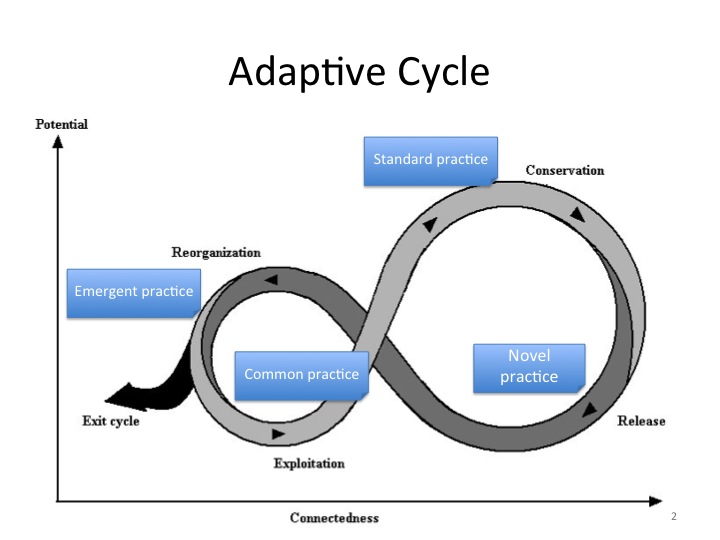
The adaptive cycle can help to make sense of the mechanisms that we use to improve practice. I have seen people use and misuse the concepts of PDCA (Plan-Do-Check-Act) and OODA (Observe-Orient-Decide-Act). Using the adaptive cycle metaphor we can clearly situate both cycles:
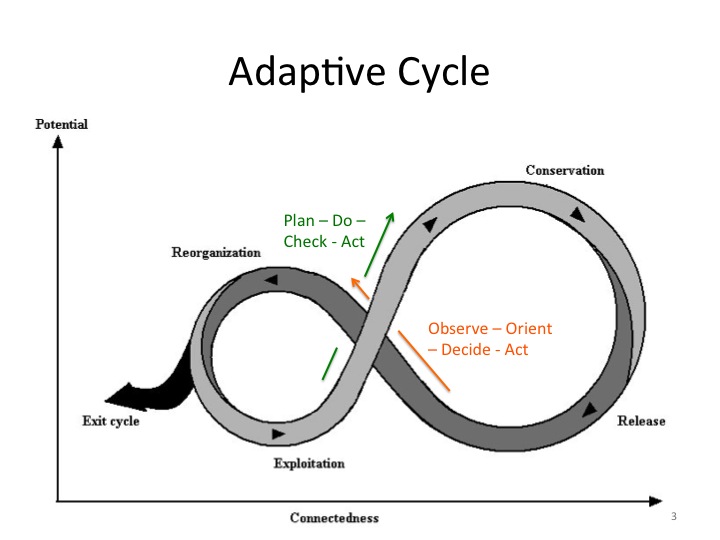
Ecological and social-ecological systems form nested sets of adaptive cycles. The larger, slower cycles generally constrain the smaller, faster ones and maintain system integrity. From the Resillience Allience:
“The fast levels invent, experiment and test; the slower levels stabilize and conserve accumulated memory of past successful, surviving experiments. The whole panarchy is both creative and conserving. The interactions between cycles in a panarchy combines learning with continuity.”
The metaphor of nested adaptive cycles can help make sense of interactions between different levels as illustrated below:
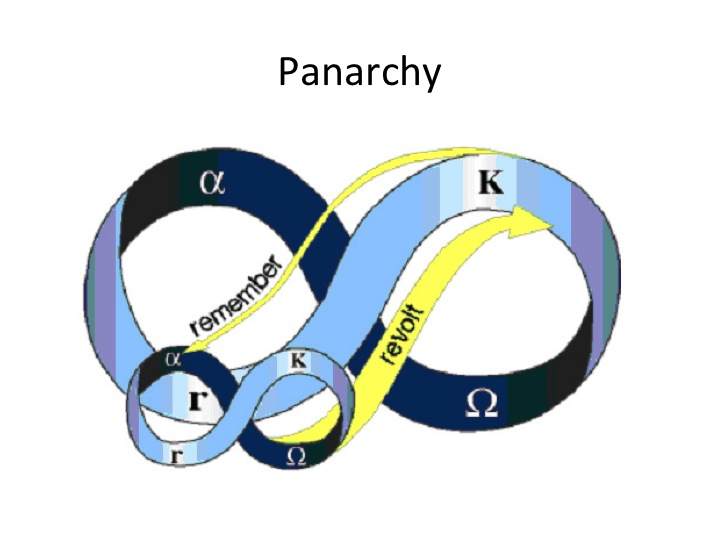
Shorter adaptive loops (of teams and features) can reinforce longer adaptive cycles (of the whole organization and the product) as illustrated below:

Note: The effect of reinforcing loops on the value curve is reminiscent of familiar J and S-curves.
Similarly, shorter adaptive loops can weaken the longer adaptive cycle. The system risks to go into a state of cascading failure.
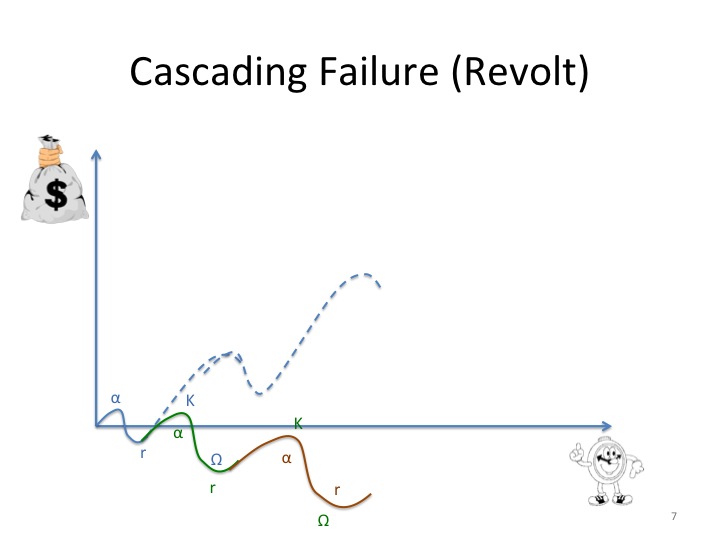
6.3 Mission and Transformational Servant Leadership (TSL)
In Transformational Servant Leadership models, organizational mission is the high level statement of what we do and often created at leadership retreats or a series of meetings designed to collaboratively develop a clear understanding of organizational identity and focus.
In TSL thinking, we focus on creating value for stakeholders. Value is embedded in the culture and reflects the organization and its stakeholders, growing from the people with a stake in the organization’s success or failure. It is not imposed, but grows from the heart’s and minds of people. Though a mission can act as a rebranding instrument, a repurposing of organizational focus or a rediscovery at the end of a life cycle, it is best used when developed during the start-up process.
Effective mission statements measure what the company does, yet there are no strict formula examples. Ben and Jerry’s Ice Cream in the US, for example, has a three-part mission focus. The first mission focus is making fantastic ice cream. Their economic mission determines effective management of the company for sustainable financial growth. Their social mission compels them to make use of company resources innovatively to make the world a better place. These three statements are central tenets to their missional focus.
They do not waver from their mission and stay where three-part mission leads them, versus wandering organizationally to create other market share opportunities.
-
What processes have you used in creating organizational mission in
places you have worked?
-
What mission focus statement(s) did you arrive at?
-
Was the process prolonged or short?
-
Did it involve the administration only or a larger group
participating in the process?
-
Did the mission focus represent the missional identity of your
organization when you finished?
-
Was the process prolonged or short?
- If you have NOT worked at a place that has an organizational mission statement, how do you think having one would have helped?
6.4 Values, Visions, and Goals
Values, mission and goals are important concepts to understand. As a TSL, your focus is a relationship-based process designed to help everyone involved (self, coworkers, customers, investors and stakeholders) find the best expression of concepts. Using a “both/and” approach versus “either/or” brings the focus on “accomplishing” your leadership journey over ”arriving” as a leader.
With a TSL alignment, community stakeholder interests are central to what you do. Achieving goals assists the community with understanding organizational plans to provide and informs them of the strategic advantages the process involves. Some of those advantages include:
- Adapting quickly to marketplace change
- If something changes, adapting quickly and in a timely manner, makes a helpful impact for the community served.
- Differentiates itself
- From others
- Focuses on clear value for results.
- By providing the same service and materials for operating, they are more capable of maintaining both the clear value provided and simplicity regarding goals accomplished.
- Use values and vision as a guide
- To reduce or discontinue activities no longer adding value to the organization. Values and vision, reductionist in scope, are designed to discontinue activities no longer needed. Proliferating activity to recreate activities to continue organizational action, guarantees you experience values or vision drift.
Take a look at a practical example below:
Example:
Ralph Klein, the former Premier of Alberta, when talking about homelessness and funding homelessness, noted one of the challenges to ending homelessness was, “every time we [the government] fund something, it becomes an industry.”” (personal communication, Alberta Legislature Hearings on Homelessness, August 25, 2006)
His concern was ending homelessness would become an industry and end up with people responding to a homelessness crisis to continue serving homelessness - Not ending it, but prolonging it and protecting the life of the organization versus jeopardizing the purpose of the organization; to end homelessness…The life of the homeless service organizations will continue by not discontinuing the services provided.
When looking at your visioning process, you need to look at the things impacting what you aim to accomplish.
If homelessness, for example, is solvable, the focus requires seeking to reduce need and discontinue activities no longer needed versus wrapping people up in a process to create an industry out of what should end and bring things to a conclusion once the vision is achieved.
What started as a solution to social problems (or problems faced in industry) becomes a lifeline focus, with vision abandoned in place of self preservation. When looking at vision and goals, organizations need guidance from personal and organizational values.
If a proposal infringes on values, we need to say no. The illustrated figure below, highlights the process for protecting mission focus:
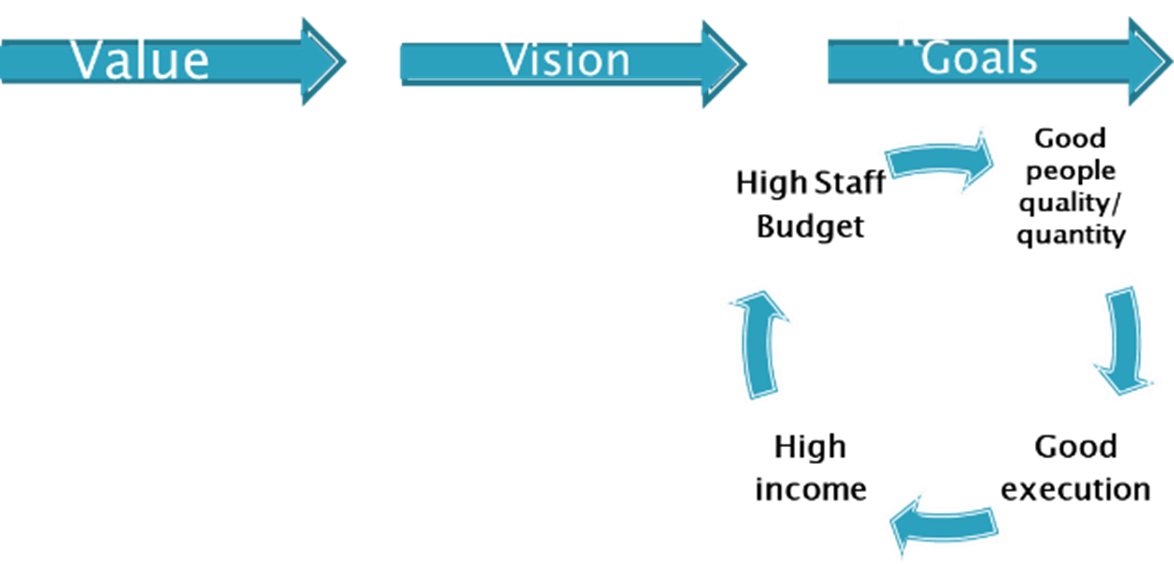
Questions to Consider
Take a few moments to consider your own experiences with visions or values statements…
-
Have you experienced a vision designed to address a need, social
concern, create an industry or constant practice of the need the
organization wanted to serve? (The need became the focus versus meeting
the need)
-
What were the circumstances?
- How might they change to allow fulfillment of the vision?
-
What were the circumstances?
-
Have you experienced people with clearly opposite missional focus
wanting to partner with your organization?
-
If yes: what was the result of the intended partnership?
-
Did you agree with the result? Disagree?
- Why did you agree or disagree?
-
Did you agree with the result? Disagree?
-
If yes: what was the result of the intended partnership?
6.5 Servant Leadership and Productivity
When we look at servant leadership and productivity, one of the biggest discussions is whether servant/transformational servant leadership is productive. The best top ten Fortune 100 companies to work for in 2017 were all servant led:
- SAS - an integrated software suite for advanced analytics, business intelligence, data management, and predictive analytics company in the US.
- Wegmans Food Market - an American supermarket chain.
- Zappos.com - an online shoe and clothing retailer.
- Nugget Market Inc. - a grocery store chain.
- Recreational Equipment Inc. - an American retail and outdoor recreation services corporation.
- The Container Store - an American specialty retail chain, which offers storage and organization products.
- Whole Foods Market Inc. - an American supermarket chain which sells products free from artificial colors, flavors, preservatives, sweeteners and hydrogenated fats, and recently acquired by Amazon Inc.
- Quick Trip - a chain of convenience stores in the Midwestern, Southern, the Southeastern United States and Arizona.
- Balfour Beatty Construction - a multinational infrastructure group based in the United Kingdom with operations in construction, support services and infrastructure investments.
- TD Industries - an American construction and technology corporation providing commercial and industrial services like air conditioning, electrical, and plumbing systems provided through general contractors.
From this list we see servant leadership and performance tied closely to a wide variety of productive organizations. You can do more research into these organizations, but understanding how each one operates within a TSL framework allows you to understand how to be productive and servant leaders at the same time. Additionally, what sets them apart is their support and promotion of an engaged workforce.
Gallup’s recent 2016 meta-analysis outlines how employee engagement consistently affects key performance outcomes, regardless of the organization’s industry or company. When management measures employee engagement it proves employee engagement helps accelerate performance. You can look at the entire analysis by following the link below and downloading the report:
Questions to Consider
- Does the information about servant-led organizations and productivity surprise you?
- Do any of the organizations listed as servant led, surprise you?
- What organizations would you add to this list? Why would you add them?
- Do you consider the organization you work with a servant-led organization?
- Why?
- Why not?
- Why?
- Does the organization you work with demonstrate servant-led characteristics?
- What specific characteristics stand out as servant led in your organizational practice?
- What specific characteristics stand out as servant led in your organizational practice?
- How could your organization practice a more successful and motivated servant leadership style?
- Try identifying three practices they could reasonably adopt.
Learning Lab
The Learning Lab for this Unit will focus on a group discussion. Additionally, it provides an opportunity for you to share your thoughts, or any questions that arose, as part of the notes you kept in your Learning Journal.
Group Discussion
The discussion this week will begin by sharing thoughts and insights regarding the following guiding prompts/questions:
When thinking of collective impact…
-
What is your understanding of collective impact? Take time to write
out your understanding of collective impact for comparison to course
readings to clarify your understanding of course content.
-
Does your organization practice collective impact?
-
If yes: What are the benefits you find in your organizational
practice?
-
If no: Is there a reason why?
-
If yes: What are the benefits you find in your organizational
practice?
-
How effective are your communication practices within your
organization?
-
Based on your assessment of your organization’s communication
effectiveness:
-
Could your organization practice collective impact?
- Why or why not?
-
Could your organization practice collective impact?
Finally, student’s will be given an opportunity to share their own thoughts, or ask any questions, that arose from their Learning Journals.
Be prepared to participate in the discussion.
Assessment
Assessment for this week will consist of a Discussion Question/Reflection Post and your first Team Assignment - the expectations for each are outlined below.
This unit’s Discussion Question/Reflection Post focuses on a comparison of one concept (Collective Impact) to another (TSL).
Unit 6 - Discussion Question/Reflection Post
Each student is required to submit a Discussion Question/Reflection Post for Unit 6. This post should include your thoughts about how the content for this unit ties into your own practice as a leader.
1. Initial Post
Discuss the role of continuous learning and adaptation of continuous learning in the collective impact context.
- How is this the same/different than TSL practice?
2. Response Post
Respond to other posts to present a framework for how you see the principles discussed in Post 1, regarding their best use of either principles represented in your organization or an organization you previously worked for.
- Provide insight into why you believe your chosen approach is preferred over the other (collective impact/TSL).
Put another way…
Look at another student’s discussion of Continuous Learning/Adaptation of Continuous Learning in a CI context or TSL context.
-
Note the principles they highlighted/discuss,
- Use their principles to create a framework for continuous/adaptable learning for a current or past organization where you worked.
Provide insight into why you believe your chosen approach is preferred over the other (collective impact/TSL).
3. Concluding Post
Offer practical guidance to other learners in the course regarding how you would implement a variety of best performance measures, evaluation activities and practices (CI, TSL, or hybrid) in your organization or one you’ve been part of.
- Any other observations you see as relevant to the discussion for the unit.
Refer to the Discussion Question/Reflection Post rubric for more specific information.
For additional information, and to submit your response, please scroll to the bottom of the screen and click on the Unit 6 - Discussion Question/Reflection Post link.
Team Assignment #1: Financial and Non-Financial Leadership Value Indicators
The purpose of this assignment is to use the information regarding leadership issues for financial stewardship and a paradigm for framing results (Demonstrating Value) to complete this assignment. Given the levels of complexity involved, feel free to use creative license where in doubt.
To complete the assignment, follow the guidelines below:
-
Select the organization of one of your team
members.
-
Develop a Transformational Servant-oriented outline of
indicators of value.
-
Review the financial and non-financial leadership elements
your team feels promotes an “effective” (balanced and focused) results
profile for the selected organization.
- Your “primary stakeholders” include the Board of Directors, CEO, CAO, and Management Team.
To help support the development of this assignment, it is strongly recommended you consider using:
-
The lectures
-
The system leadership imperative
-
Any information about the Collective Impact Forum (See URL provided
in Week 5 Reading Week materials);
-
The Deloitte presentation
-
Information on the Ecosystem Economy,
- Any other course information you feel is appropriate.
Presentation
Your submission for this assignment will be in the format of a presentation. This presentation should follow the listed criteria:
- A 10 slide PowerPoint or a 25 station Prezi
Include:
-
The Organization:
-
Create sample indicators for presenting 2 primary levels of
information:
-
Financial (Financial accounting and issues)
-
Non-financial (May be viewed as Social Accounting) organization
leadership
-
Financial (Financial accounting and issues)
- “Cascade” information as you see fit.
-
Create sample indicators for presenting 2 primary levels of
information:
Note: Use the notes portion of your ppt to maximize your 10 slide limit.
Note: The presentation will be made available to other teams during Unit 7 for review and peer review grading and improvement suggestions before final grading is applied.
Checking for Learning
Before moving on to the next unit, be sure you are able to:
-
Identify the benefits of TSL resilience loops in their organizational
operation.
-
Recognize the importance of implementing effective employee
engagement principles for best practices results.
- Describe best practices for developing employee/staff performance processes in their organization.
Resources
On this page, you will find resources that help further your understanding of the content explored in this unit. This resources have been provided to support, and enrich, your learning. While they are not all “required” reading/viewing, it is strongly recommended that you take some time look over them - if there is a topic that you are struggling to understand, consider spending more time looking through the resources on this page.
- Why the Lean Start-up Changes Everything: Ths is an article providing a brief overview of lean start-up techniques and how they’ve evolved, along with a combination of other business trends and how they can ignite new entrepreneurial economic opportunities.
- Emotional Intelligence and Money: This is an article that explains the ability for making wise choices even when our brains are flooded with emotion-producing chemicals that cause us to make poor choices.
- Peter Senge and the Learning Organization: This is an article exploring Peter Senge’s vision of the learning organization.
- The Beginner’s Guide to Reading and Understanding Financial Statements: If you are new to the world of financial statements, this guide can help you read and understand the information contained in them.
- Beyond Budgeting Principles Update: A white paper exploring how traditional budgeting practices work against each other, and how the Beyond Budgeting principles enable organizations to overcome these limitations and empower organizations to higher performance.
- Organizational Accountability: This is a brief survey to evaluate accountability practices in your workplace.
- Ready to Innovate? 6 Key Questions to Test Your Organization’s Innovation Readiness: 6 survey questions to determine organizational readiness for innovation with an opportunity to evaluate your answers.
Video Resources
- 10 Steps to Creating a Balanced Scorecard: This video does what it says it will do. It outlines the 10 steps to creating a Balanced Scorecard (BSC).
- Evaluating Collective Impact Webinar: This video provides an overview for understanding the practical application of Collective Impact principle and practice in a webinar format.
- Hallie Paskill – Evaluating Collective Impact: This video outlines the Collective Impact Guide and provides introductory material to the collective impact process.
- The Explainer – The Balanced Scorecard: This video outlines the four perspectives to consider in developing your BSC for the long term.